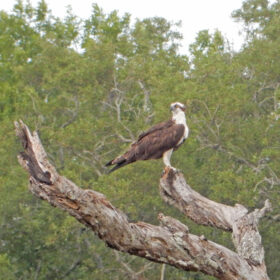By Pat Foster-Turley
January 27, 2023

I’m sure most of you zoom on State Road A1A right past the retention pond that was added along with a parking lot at the south end of Little Talbot Island many years ago. This is an uninteresting looking body of water right before you drive across the Simpson Creek Bridge and on to Jacksonville by “the other route” that many of us follow when leaving Amelia Island. But for Bucko and I, this pond is sometimes an interesting place to make a quick stop to look around.
We have watched this pond and the surrounding area change over the years. Years ago there were a lot of tall dead pine trees near the pond that, during the mullet run season, were often occupied by ospreys perching there to easily spy the fish in the river. Sometimes a half dozen or more ospreys were perched there, each to its own large pine snag lookout point. But dead trees have a short “life span” and now all that remains is one old tree skeleton and, if we are lucky, one osprey.
But in recent years one aspect of this pond has been greatly improved. During the shorebird breeding season across the water in Huguenot Park many birds, mostly laughing gulls, flew into this freshwater pond for drinks of freshwater. This meant flying low across SR A1A where many of them got smashed by fast-moving vehicles. For a few sad years Bucko and I counted sometimes as many as five dead birds on this little stretch of highway whenever we drove by during the spring and summer nesting time. It took a few years and a lot of money but this problem has now been solved. When you drive by now you see many tall palm trees and lots of Florida native plants landscaping the area and forcing the birds to fly higher than the highway to get to the pond. No more dead gulls on the road. Wonderful!

While the landscaping improvements were underway, the access to the pond and its parking lot was closed. Although it is now open again for fishermen, visitors to the riverside beach areas, and hiking opportunities, it has been many months since Bucko and I paid the pond a visit. Admittedly, from the vantage point of the road, while driving by, it is an uninteresting place – a couple of man-made ponds with mowed surroundings.
The pond itself is nondescript at first glance, but stopping by the adjacent parking lot provides interesting views of the changing sandbars in the river and the bridge above, and the boat traffic, kayakers, and others passing through. Although there are signs clearly stating the strong currents and dangers of entering the water in this area, in summertime it is often full of bathers, risking it for a cooling dip.
Like everything else, though, the pond itself gets more interesting with a closer look. Recently Bucko and I did just that, and happened upon an interesting glimpse at animal behavior – cooperative fishing. A great egret was fishing from the shore in its “stand and wait” strategy, and a merganser was chasing fish towards the shore, looking to corner its own catch. When fish were chased towards the waiting egret, it could catch one. And, vice versa, when a stabbing egret beak chased fish further into the pond the merganser was there to grab it. Whether they both knew they were cooperating is another matter, but it is a strategy that works, and can be seen again and again in many ponds in our area in the winter when the mergansers are with us.

For those who are actual birders unlike Bucko and I who just like watching bird behavior and not making species lists of birds seen, there are sites to help you record more about the birds you see. Check out this ebird link (https://ebird.org/hotspots) and type in “Little Talbot Island-Fort George Inlet,” and you will quickly find that 122 species of birds have all been spotted by birders near this pond.
If you are not in a hurry to rush by on the highway to other places, give the pond and adjacent parking lot a look and you might be surprised yourself at what you see. It’s all in taking the time to look. As we age, Bucko and I are getting much better at this, at last!
Pat Foster-Turley, Ph.D., is a zoologist on Amelia Island. She welcomes your nature questions and observations. [email protected]

Thanks for this tip on another local wildlife viewing spot. We are very fortunate to have great state parks and the Timucuan Preserve so close to us. By the way, I have witnessed cooperative fishing, that, indeed, seems very intentional, by at least four different bird species at Spoonbill Pond just a bit north on Big Talbot Island.